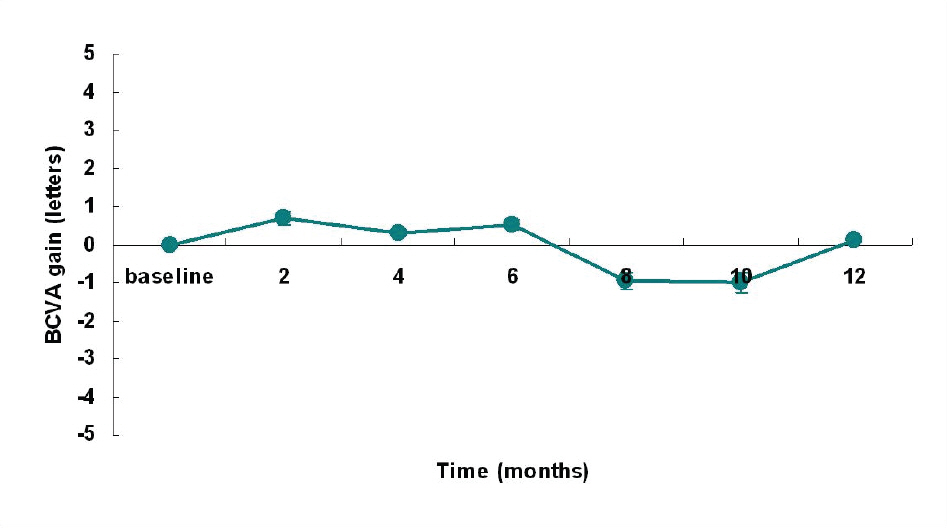J Korean Ophthalmol Soc.
2008 Oct;49(10):1629-1633.
Clinical Evaluation of Patients with Nonproliferative Diabetic Retinopathy Following Medication of Anthocyanoside: Multicenter Study
- Affiliations
-
- 1Department of Ophthalmology, KyungHee University College of Medicine, Seoul, Korea. hwkwak@khu.ac.kr
- 2Department of Ophthalmology, Kyungpook National University, College of Medicine, Daegu, Korea.
- 3Department of Ophthalmology, Yonsei University College of Medicine, Seoul, Korea.
- 4Seoul National University Boramae Hospital, Seoul, Korea.
- 5Department of Ophthalmology, Chonnam National University Medical School & Hospital, Gwangju, Korea.
- 6Department of Ophthalmology, College of Medicine, Pusan National University, Pusan, Korea.
- 7Department of Ophthalmology, Konyang University, Kim's Eye Hospital, Seoul, Korea.
- 8Department of Ophthalmology, Seoul National University College of Medicine, Seoul, Korea.
Abstract
- PURPOSE
To prospectively investigate the change of clinical manifestations after 1 year of administration of anthocyanoside (Tagen-F(R)) to patients with NPDR-associated macular edema.
METHODS
One hundred seventy-five eyes in 88 patients were enrolled in this study, at 5 centers, from March, 2005 to October, 2005. Patients took 3 capsules of Vaccinium myrtillus extract (170 mg/capsule, Tagen-F(R), Kukje pharmaceutical) per day. The primary endpoints were corrected visual acuity and contrast sensitivity which were checked at 2 months following the beginning of treatment [East 1]. The secondary endpoints were the number of hard exudates, microaneurysms, leaking points and the changes of foveal thickness. These were examined at the beginning of, 6 months after, and 12 months after treatment.
RESULTS
Corrected visual acuity showed no significant changes during 12 months. Contrast sensitivity improved gradually, especially in 12, 16 cycles per degree [East 2]. There was no statistically significant changes in the numbers of hard exudates, microaneurysms, and leaking points. Foveal thickness measured by OCT was maintained and there was no aggravation of macular edema.
CONCLUSIONS
There was marked improvement of contrast sensitivity in patients with NPDR after 1 year of administration of anthocyanoside (Tagen-F(R)), and it might contribute to the quality of vision and the satisfaction of patients. Visual acuity and macular edema were maintained without aggravation.
Keyword
MeSH Terms
Figure
Reference
-
References
1. Amos AF, McCarthy DJ, Zimmet P.The rising global burden of diabetes and its complications: estimates and projections to the year 2010. Diabetic Med. 1997; 14:S1–85.
Article2. Aiello LP, Gardner TW, King GL. . Diabetic retinopathy. Diabetes Care. 1998; 21:143–56.
Article3. Brownlee M. Biochemistry and molecular cell biology of diabetic complications. Nature. 2001; 414:813–20.
Article4. Yamagishi S, Imaizumi T. Diabetic vascular complications: pathophysiology, biochemical basis and potential therapeutic strategy. Curr Pharm Des. 2005; 11:2279–99.
Article5. Nishikawa T, Edelstein D, Du XL. . Normalizing mitochondrial superoxide production blocks three pathways of hyperglycaemic damage. Nature. 2000; 404:787–90.
Article6. Feldman EL. Oxidative stress and diabetic neuropathy: a new understanding of an old problem. J Clin Invest. 2003; 111:431.
Article7. Vessby J, Basu S, Mohsen R. . Oxidative stress and antioxidant status in type 1 diabetes mellitus. J Intern Med. 2002; 251:69–76.
Article8. Marra G, Cotroneo P, Pitocco D. . Early increase of oxidative stress and reduced antioxidant defenses in patients with uncomplicated type 1 diabetes: a case for gender difference. Diabetes Care. 2002; 25:370–5.9. Reunanen A, Knekt P, Aaran RK, Aromaa A. Serum antioxidants and risk of non-insulin dependent diabetes mellitus. Eur J Clin Nutr. 1998; 52:89–93.
Article10. Rahimi R, Nikfar S, Larijani B, Abdollahi M. A review on the role of antioxidants in the management of diabetes and its complications. Biomed Pharmacother. 2005; 59:365–73.
Article11. Busciala A, Bosisio E. Vascular effects of wine ployphenols. Cardiovas Res. 2004; 63:593–602.12. Amano S, Yamagishi S, Kato N. . Sorbitol dehydrogenase overexpression potentiates glucose toxicity to cultured retinal pericytes. Biochem Biophys Res Commun. 2002; 299:183–8.
Article13. Lekakis J, Rallidis LS, Andreadou I. . Polyphenolic compounds from red grapes acutely improve endothelial function in patients with coronary heart disease. Eur J Cardiovasc Prev Rehabil. 2005; 12:596–600.
Article14. Burns J, Gardner PT, O'Neil J. . Relationship among antioxidant activity, vasodilation capacity and phenolic contents of red wines. J Agric Food Chem. 2000; 48:220–30.15. Jindra LF, Zemon V. Contrast sensitivity testing: A more complete assessment of vision. J Cataract Refract Surg. 1989; 14:141–8.
Article16. Kim EA, Koo YJ, Han YB. Contrast sensitivity changes in patients with diabetic retinopathy. J Korean Ophthalmol Soc. 1995; 36:1523–8.17. Arend O, Remky A, Evans D. . Contrast sensitivity loss is coupled with capillary dropout in patients with diabetes. Invest Ophthalmol Vis Sci. 1997; 38:1819–24.18. Klein R, Meuer SM, Moss SE, Klein BE. Retinal microaneurysm counts and 10-year progression of diabetic retinopathy. Arch Ophthalmol. 1995; 113:1386–91.
Article
- Full Text Links
- Actions
-
Cited
- CITED
-
- Close
- Share
- Similar articles
-
- Influence of Peripapillary Atrophy on the Progress of Diabetic Retinopathy
- The Changes in Macular Thickness after Phacoemulsification in Patients with Non-diabetes and Nonproliferative Diabetic Retinopathy
- Changes of ERG Parameters in Diabetic Retinopathy
- The Influences of Arteriosclerosis on the Development and Progression of Diabetic Retinopathy
- Ultrawide-field Fluorescein Angiography for Evaluation of Diabetic Retinopathy




